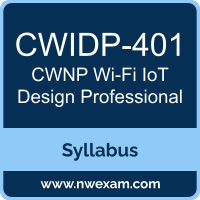 A great way to start the CWNP Certified Wireless IoT Design Professional (CWIDP) preparation is to begin by properly appreciating the role that syllabus and study guide play in the CWNP CWIDP-401 certification exam. This study guide is an instrument to get you on the same page with CWNP and understand the nature of the CWNP Wi-Fi IoT Design Professional exam.
A great way to start the CWNP Certified Wireless IoT Design Professional (CWIDP) preparation is to begin by properly appreciating the role that syllabus and study guide play in the CWNP CWIDP-401 certification exam. This study guide is an instrument to get you on the same page with CWNP and understand the nature of the CWNP Wi-Fi IoT Design Professional exam.
Our team of experts has composed this CWNP CWIDP-401 exam preparation guide to provide the overview about CWNP Wireless IoT Design Professional exam, study material, sample questions, practice exam and ways to interpret the exam objectives to help you assess your readiness for the CWNP CWIDP exam by identifying prerequisite areas of knowledge. We recommend you to refer the simulation questions and practice test listed in this guide to determine what type of questions will be asked and the level of difficulty that could be tested in the CWNP Wi-Fi IoT Design Professional certification exam.
CWNP CWIDP-401 Exam Overview:
|
Exam Name
|
Wireless IoT Design Professional |
| Exam Number | CWIDP-401 CWIDP |
| Exam Price | $350 USD |
| Duration | 90 minutes |
| Number of Questions | 60 |
| Passing Score | 70% |
| Exam Registration | Prometric |
| Sample Questions | CWNP CWIDP-401 Sample Questions |
| Practice Exam | CWNP Certified Wireless IoT Design Professional Practice Test |
CWNP CWIDP-401 Exam Topics:
| Section | Weight | Objectives |
|---|---|---|
| Assess an Existing IoT Solution | 5% |
- Evaluate an existing IoT implementation and understand its impact on a new wireless IoT deployment
- Use appropriate tools to analyze existing IoT implementations
- Gather system documentation for the existing IoT solution
- Evaluate operational parameters
- Document findings for use in the design of the new wireless IoT solution
|
| Gather and Define Requirements and Constraints | 30% |
- Gather business requirements and constraints
- Gather technical requirements and constraints
|
| Design a Wireless IoT Solution to Meet Requirements | 40% |
- Design for the selected topologies
- Design for appropriate channel configuration
- Design based on RF requirements and capabilities
- Use wireless IoT tools to create and validate the design
- Produce or recommend designs and configuration parameters for the IoT related network infrastructure requirements
- Produce design documentation
|
| Validate and Optimize the Wireless IoT Solution | 25% |
- Validate that the RF requirements are met by the solution
- Validate that the IoT solution is functioning as defined in the solution requirements
- Recommend and/or perform appropriate corrective actions as needed based on validation results for RF requirements and IoT solution functionality requirements
- Create a validation and test report including solution documentation and asset inventory/asset documentation - Final meeting (Q&A and hand-off) |
CWNP CWIDP Exam Description:
The Certified Wireless IoT Design Professional (CWIDP) has the knowledge and skill set required to define, design, validate and assess wireless IoT solutions. This professional gathers and defines requirements in collaboration with the appropriate stakeholders in order to design wireless IoT networks and related infrastructure with appropriate security considerations. The CWIDP creates design documentation to support the deployment of the required system components and future operations.
